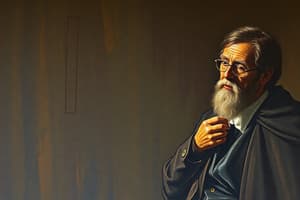Podcast
Questions and Answers
According to the Rescorla-Wagner theory, what effect occurs when 2 fully conditioned stimuli are combined into a compound stimulus and then subjected to further pairings with the UCS?
According to the Rescorla-Wagner theory, what effect occurs when 2 fully conditioned stimuli are combined into a compound stimulus and then subjected to further pairings with the UCS?
- Reduction effect (correct)
- Compound conditioning effect
- Overexpectation effect
- Increase effect
In a compound stimulus with an associative value of 25, if one CS has acquired 15 units of associative value, how many units of associative value must the other CS have acquired according to the Rescorla-Wagner theory?
In a compound stimulus with an associative value of 25, if one CS has acquired 15 units of associative value, how many units of associative value must the other CS have acquired according to the Rescorla-Wagner theory?
- 5 (correct)
- 10
- 25
- 20
If a tone and a light are each conditioned with food to a maximum associative value of 8 units, what will happen to the associative value of each stimulus when they are combined into a compound stimulus for further conditioning trials?
If a tone and a light are each conditioned with food to a maximum associative value of 8 units, what will happen to the associative value of each stimulus when they are combined into a compound stimulus for further conditioning trials?
- Decrease (correct)
- Increase
- Remain unchanged
- Overexpectation
When Uncle Bob and Aunt Shirley resolved their difficulties and gave Little Lucas one great present from the two of them, the Rescorla-Wagner theory predicts that Little Lucas’s positive feelings for each will become:
When Uncle Bob and Aunt Shirley resolved their difficulties and gave Little Lucas one great present from the two of them, the Rescorla-Wagner theory predicts that Little Lucas’s positive feelings for each will become:
In a compound stimulus consisting of a buzzer and a light flash, if the buzzer has acquired 14 units of associative value following pairings with a sweet drink, what does this indicate about the light flash?
In a compound stimulus consisting of a buzzer and a light flash, if the buzzer has acquired 14 units of associative value following pairings with a sweet drink, what does this indicate about the light flash?
According to the text, what is the main idea of specificity in classical conditioning?
According to the text, what is the main idea of specificity in classical conditioning?
What is overshadowing in classical conditioning?
What is overshadowing in classical conditioning?
Which example best illustrates the concept of overshadowing from the text?
Which example best illustrates the concept of overshadowing from the text?
What is the key idea behind latent inhibition in classical conditioning?
What is the key idea behind latent inhibition in classical conditioning?
In classical conditioning, what does specificity refer to?
In classical conditioning, what does specificity refer to?
Which scenario best exemplifies latent inhibition in classical conditioning?
Which scenario best exemplifies latent inhibition in classical conditioning?
Which phenomenon is similar to the 'Antonio effect' in classical conditioning?
Which phenomenon is similar to the 'Antonio effect' in classical conditioning?
What is the primary difference between blocking and overshadowing in classical conditioning?
What is the primary difference between blocking and overshadowing in classical conditioning?
In which phenomenon is a familiar stimulus harder to condition as a CS than a new, unfamiliar stimulus in classical conditioning?
In which phenomenon is a familiar stimulus harder to condition as a CS than a new, unfamiliar stimulus in classical conditioning?
According to the Rescorla-Wagner theory, what happens when a more salient CS is presented in classical conditioning?
According to the Rescorla-Wagner theory, what happens when a more salient CS is presented in classical conditioning?
What does the Rescorla-Wagner theory propose about the conditioning of a given unconditioned stimulus (UCS) and various conditioned stimuli (CSs)?
What does the Rescorla-Wagner theory propose about the conditioning of a given unconditioned stimulus (UCS) and various conditioned stimuli (CSs)?
What is the primary similarity between blocking and overshadowing in classical conditioning?
What is the primary similarity between blocking and overshadowing in classical conditioning?
Flashcards are hidden until you start studying
Study Notes
- Three examples of specificity in classical conditioning were discussed.
- The first example is the "Antonio effect" where a more noticeable player overshadows a less noticeable one, similar to how a more salient stimulus can overshadow a less salient one in classical conditioning.
- Blocking is a form of specificity where the presence of an established conditioned stimulus (CS) inhibits the conditioning of a new CS when they are presented together.
- Blocking is similar to overshadowing but involves a neutral stimulus (NS) instead of two neutral stimuli.
- In taste aversion, a familiar stimulus (food) is harder to condition as a CS than a new, unfamiliar stimulus (nausea) due to a phenomenon called latent inhibition.
- Latent inhibition helps prevent the development of conditioned associations to redundant stimuli and promotes adaptation to novel stimuli.
- The Rescorla-Wagner theory proposes that a given unconditioned stimulus (UCS) can only support a certain amount of conditioning, and this conditioning must be distributed among the various conditioned stimuli available.
- Overshadowing occurs because the more salient CS absorbs most of the available associative value, leaving less for other CSs.
- In blocking, the CS that has already acquired maximum associative value prevents the other CS from acquiring any associative value.
- The Rescorla-Wagner theory suggests that a more salient CS picks up more of the available associative value in a given setting.
Studying That Suits You
Use AI to generate personalized quizzes and flashcards to suit your learning preferences.





